Valorization of Phosphate Mine Waste Rocks as Materials for Road Construction
Abstract
1. Introduction
2. Materials and Methods
2.1. Materials Sampling
2.2. Research Methodology
2.2.1. Laboratory Tests
2.2.2. In Situ Tests
3. Results and Discussion
3.1. PMWR Characterization
3.1.1. Physical and Geotechnical Properties
3.1.2. Chemical and Mineralogical Properties
3.1.3. Environmental Behavior of Materials
3.2. In situ Full Trial Tests
3.3. Risks Factors Evaluation
4. Conclusions
- The mechanical behavior of these materials depends essentially on their flintstone and clay content.
- The chemical and mineralogical composition and leaching tests on PMWR suggests that they are chemically inert.
- The in situ full trial testing has defined the optimal compaction condition for the use of PMWR in ordinary embankment construction (used in a wet way). It consists of a compaction energy of four passes, a speed of a V4 vibratory roller compactor of 4 km/h and a thickness of the compacted layers of 30 cm.
- Embankments up to 15 m height can be built with PMWR without any significant physical instability risks. The respect of the constructive provisions is necessary.
Author Contributions
Funding
Acknowledgments
Conflicts of Interest
Acronyms and Abbreviations
| Corg | Organic carbon content |
| LA | Los Angeles abrasion value |
| MD | Micro Deval value |
| TCLP | Toxicity characteristic leaching procedure |
| XRD | X-ray diffraction |
| PMWR | Phosphate mine waste rocks |
| wopn | Optimum water content of the standard Proctor test |
| CBR | California bearing ratio |
| MBV | Methylene blue value |
| ρs | specific (particle) density |
| γdr | reference dry density |
| OCDE | Organisation de cooperation et de développement économiques |
References
- OCDE. Utilisation des Déchets et Sous-Produits en Technique Routière Système d’archivage DSpace/Manakin; OCDE: Paris, France, 1977. [Google Scholar]
- Sayagh, S. Approche Multicritère de l’utilisation des Matériaux Alternatifs Dans Les Chaussées; Ecole des Ponts ParisTech: Marne-la-Vallée, France, 2007. [Google Scholar]
- Lidelöw, S.; Mácsik, J.; Carabante, I.; Kumpiene, J. Leaching behaviour of copper slag, construction and demolition waste and crushed rock used in a full-scale road construction. J. Environ. Manag. 2017, 204, 695–703. [Google Scholar] [CrossRef] [PubMed]
- Anupam, A.K.; Kumar, P.; Ransinchung, G. Use of various agricultural and industrial waste materials in road construction. Procedia-Soc. Behav. Sci. 2013, 104, 264–273. [Google Scholar] [CrossRef]
- Toraldo, E.; Saponaro, S.; Careghini, A.; Mariani, E. Use of stabilized bottom ash for bound layers of road pavements. J. Environ. Manag. 2013, 121, 117–123. [Google Scholar] [CrossRef] [PubMed]
- Lynn, C.J.; Ghataora, G.S.; OBE, R.K.D. Municipal incinerated bottom ash (MIBA) characteristics and potential for use in road pavements. Int. J. Pavement Res. Technol. 2017, 10, 185–201. [Google Scholar] [CrossRef]
- Vizcarra, G.O.C.; Casagrande, M.D.T.; da Motta, L.M.G. Applicability of municipal solid waste incineration ash on base layers of pavements. J. Mater. Civ. Eng. 2013, 26, 06014005. [Google Scholar] [CrossRef]
- Arulrajah, A.; Piratheepan, J.; Disfani, M.M.; Bo, M.W. Geotechnical and geoenvironmental properties of recycled construction and demolition materials in pavement subbase applications. J. Mater. Civ. Eng. 2012, 25, 1077–1088. [Google Scholar] [CrossRef]
- Cardoso, R.; Silva, R.V.; de Brito, J.; Dhir, R. Use of recycled aggregates from construction and demolition waste in geotechnical applications: A literature review. Waste Manag. 2016, 49, 131–145. [Google Scholar] [CrossRef] [PubMed]
- Shen, W.; Zhou, M.; Ma, W.; Hu, J.; Cai, Z. Investigation on the application of steel slag–fly ash–phosphogypsum solidified material as road base material. J. Hazard. Mater. 2009, 164, 99–104. [Google Scholar] [CrossRef] [PubMed]
- Cuadri, A.; Navarro, F.; García-Morales, M.; Bolívar, J. Valorization of phosphogypsum waste as asphaltic bitumen modifier. J. Hazard. Mater. 2014, 279, 11–16. [Google Scholar] [CrossRef] [PubMed]
- Sorlini, S.; Sanzeni, A.; Rondi, L. Reuse of steel slag in bituminous paving mixtures. J. Hazard. Mater. 2012, 209, 84–91. [Google Scholar] [CrossRef] [PubMed]
- Eskioglou, P.; Oikonomou, N. Protection of environment by the use of fly ash in road construction. Glob. Nest J. 2008, 10, 108–113. [Google Scholar]
- Dubois, V.; Abriak, N.E.; Zentar, R.; Ballivy, G. The use of marine sediments as a pavement base material. Waste Manag. 2009, 29, 774–782. [Google Scholar] [CrossRef] [PubMed]
- Wang, D.X.; Abriak, N.E.; Zentar, R.; Xu, W. Solidification/stabilization of dredged marine sediments for road construction. Environ. Technol. 2012, 33, 95–101. [Google Scholar] [CrossRef]
- Zentar, R.; Dubois, V.; Abriak, N.E. Mechanical behaviour and environmental impacts of a test road built with marine dredged sediments. Resour. Conserv. Recycl. 2008, 52, 947–954. [Google Scholar] [CrossRef]
- Miraoui, M.; Zentar, R.; Abriak, N.-E. Road material basis in dredged sediment and basic oxygen furnace steel slag. Constr. Build. Mater. 2012, 30, 309–319. [Google Scholar] [CrossRef]
- Hakkou, R.; Benzaazoua, M.; Bussière, B. Laboratory evaluation of the use of alkaline phosphate wastes for the control of acidic mine drainage. Mine Water Environ. 2009, 28, 206. [Google Scholar] [CrossRef]
- Ouakibi, O.; Loqman, S.; Hakkou, R.; Benzaazoua, M. The potential use of phosphatic limestone wastes in the passive treatment of AMD: A laboratory study. Mine Water Environ. 2013, 32, 266–277. [Google Scholar] [CrossRef]
- Ouakibi, O.; Hakkou, R.; Benzaazoua, M. Phosphate carbonated wastes used as drains for acidic mine drainage passive treatment. Procedia Eng. 2014, 83, 407–414. [Google Scholar] [CrossRef]
- Bossé, B.; Bussière, B.; Hakkou, R.; Maqsoud, A.; Benzaazoua, M. Assessment of phosphate limestone wastes as a component of a store-and-release cover in a semiarid climate. Mine Water Environ. 2013, 32, 152–167. [Google Scholar] [CrossRef]
- GMTR. Direction des Routes et de la Circulation Routière. 2002. Guide Marocain pour les Terrassements Routier, Fascicule 1; Royaume du Maroc; Ministère de l’Equipement: Rabat, Morocco, 2002; 106p.
- Ahmed, A.; Abouzeid, A. Potential use of phosphate wastes as aggregates in road construction. J. Eng. Sci 2009, 37, 413–422. [Google Scholar]
- NF-P11-300. Exécution des Terrassements—Classification des Matériaux Utilisables dans la Construction des Remblais et des Couches de Forme d’infrastructures Routières; Association Française de Normalisation: Paris, France, 1992. [Google Scholar]
- EPA-1311. SW-846 Test Method 1311: Toxicity Characteristic Leaching Procedure; EPA: Washington, DC, USA, 1992. [Google Scholar]
- US-EPA. Hazardous Waste Characteristics. A User-Friendly Reference Document; EPA: Washington, DC, USA, 2009. [Google Scholar]
- ISO-14235. Soil Quality—Determination of Organic Carbon by Sulfochromic Oxidation; ISO: Geneva, Switzerland, 1998. [Google Scholar]
- NF-P94-048. Soil: Investigation and Testing—Determination of the Carbonate Content—Calcimeter Method—Sols: Reconnaissance et essais; Association Française de Normalisation: Paris, France, 1996. [Google Scholar]
- NF-P94-050. Soils: Investigation and Testing. Determination of Moisture Content. Oven Drying Method; Association Française de Normalisation: Paris, France, 1995. [Google Scholar]
- NF-P94-051. Soil: Inverstigation and Testing. Determination of Atterberg’s Limits. Liquid Limit Test Using Cassagrande Apparatus. Plastic Limit Test on Rolled Thread—Sols: Reconnaissance et Essais; Association Française de Normalisation: Paris, France, 1993. [Google Scholar]
- NF-P94-052-1. Soil: Investigation and Testing. Atterberg Limit Determination. Part 1: Liquid Limit. Cone Penetrometer Method—Sols: Reconnaissance et essais; Association Française de Normalisation: Paris, France, 1995. [Google Scholar]
- NF-P94-056. Soil: Investigation and Testing. Granulometric Analysis. Dry Sieving Method after Washing—Sols: Reconnaissance et essais; Association Française de Normalisation: Paris, France, 1996. [Google Scholar]
- NF-P94-068. Soils: Investigation and Testing. Measuring of the Methylene Blue Adsorption Capacity of à Rocky Soil. Determination of the Methylene Blue of à Soil by Means of the Stain test—Sols: Reconnaissance et essais; Association Française de Normalisation: Paris, France, 1998. [Google Scholar]
- NF-P94-093. Soils: Investigation and Testing—Determination of the Compaction Reference Values of a Soil Type—Standard Proctor Test—Modified Proctor Test—Sols: Reconnaissance et essais—Détermination des références de compactage d’un matériau—Essai Proctor Normal—Essai Proctor modifié; Association Française de Normalisation: Paris, France, 2014. [Google Scholar]
- P18-573. Aggregates. Los Angeles Test—Granulate. los Angeles Pruefung; Association Française de Normalisation: Paris, France, 1990. [Google Scholar]
- P18-572. Aggregates. Micro-Deval Attribution Test; Association Française de Normalisation: Paris, France, 1990. [Google Scholar]
- NF-P94-066. Soils: Investigation and Tests. Fragmentability Coefficient of Rocky Material—Sols: Reconnaissance et essais; Association Française de Normalisation: Paris, France, 1992. [Google Scholar]
- NF-P94-067. Soils: Investigation and Tests. Degradability Coefficient of ROCKY material—Sols: Reconnaissance et essais; Association Française de Normalisation: Paris, France, 1992. [Google Scholar]
- NF-P94-078. Soils: Investigation and Tests. CBR after Immersion. Immediate CBR. Immediate Bearing Ratio. Measurement on Sample Compacted in CBR Mould—Sols: Reconnaissance et essais; Association Française de Normalisation: Paris, France, 1997. [Google Scholar]
- NF-P94-071-1. Soil Investigation and Testing. Direct Shear Test with Shearbox Apparatus. Part 1: Direct Shear—Sols: Reconnaissance et essais; Association Française de Normalisation: Paris, France, 1994. [Google Scholar]
- XP-P94-090-1. Soil: Investigation and Testing. Oedometric Test. Part 1: Compressibility Test on Quasi Satured Fine Grained Soil with Loading in Increments; Association Française de Normalisation: Paris, France, 1997. [Google Scholar]
- NF-P94-061-2. Soils: Investigation and Testing. Determination of Density of Materials on Site. Part 2: Membrane Densitometer Method—Sols: Reconnaissance et Essais; Association Française de Normalisation: Paris, France, 1996. [Google Scholar]
- NF-P98-736. Road Construction and Maintenance Equipment. Compactors. Classification—Matériel de Construction et d’entretien des Routes; Association Française de Normalisation: Paris, France, 1992. [Google Scholar]
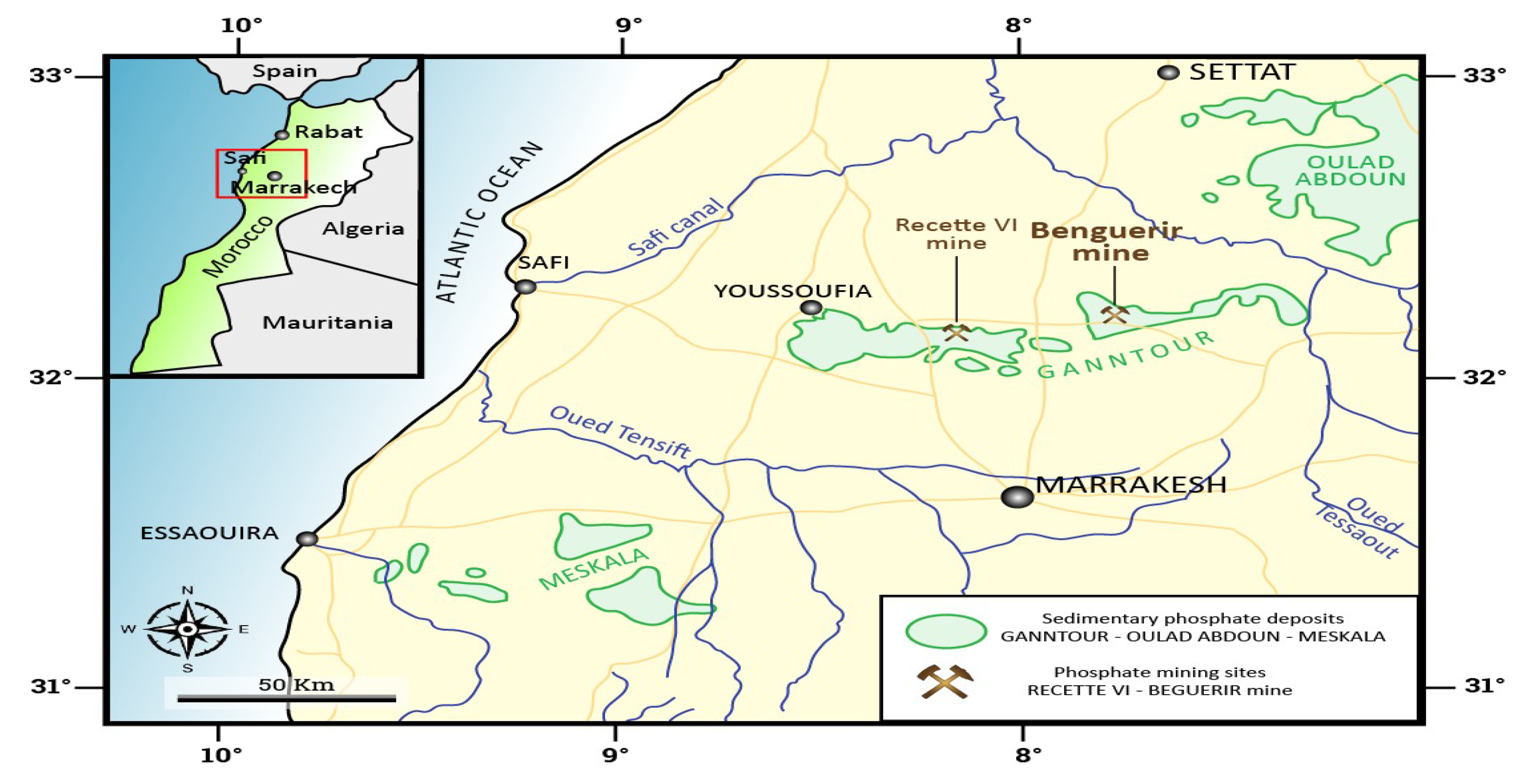
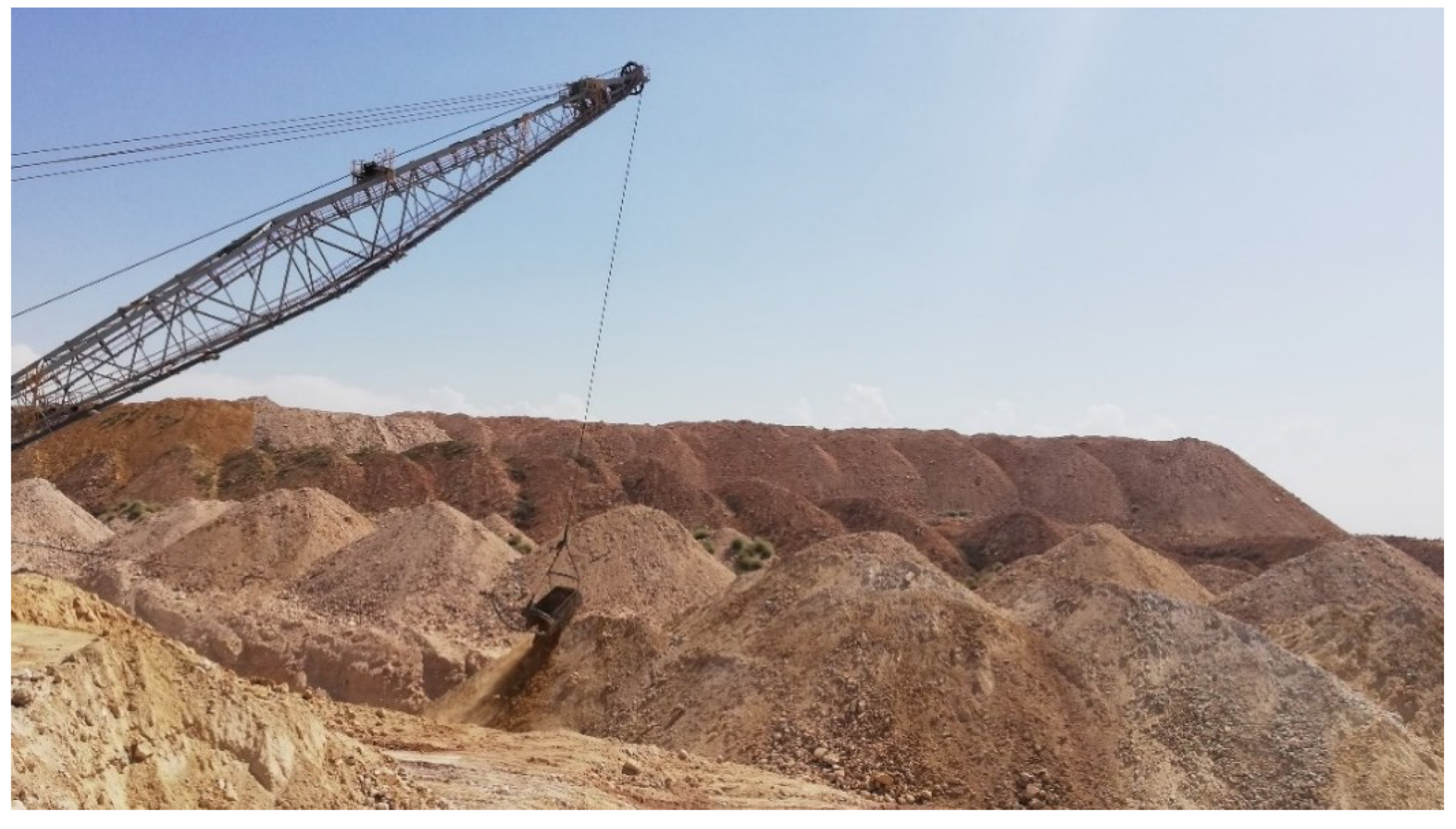
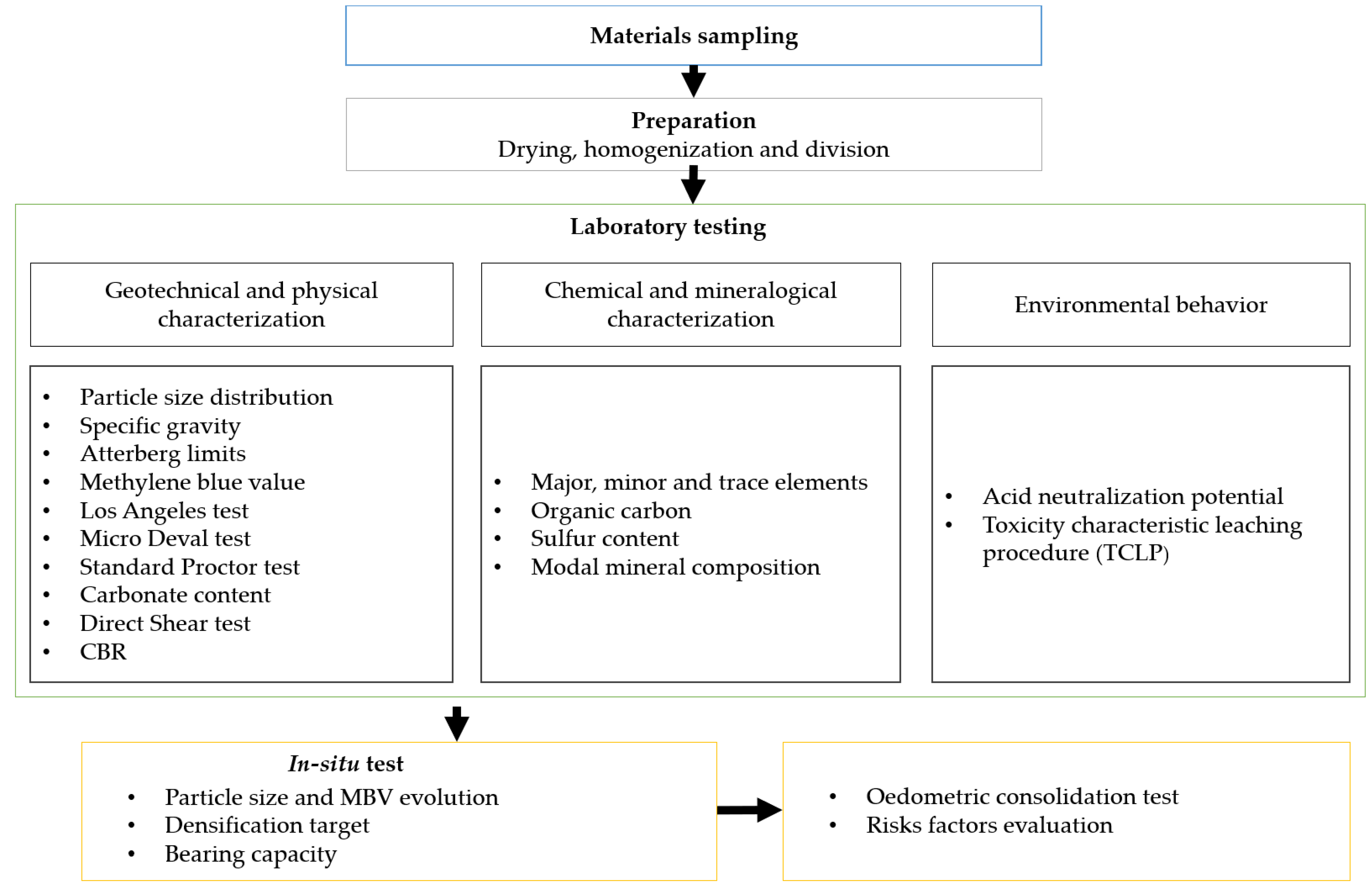
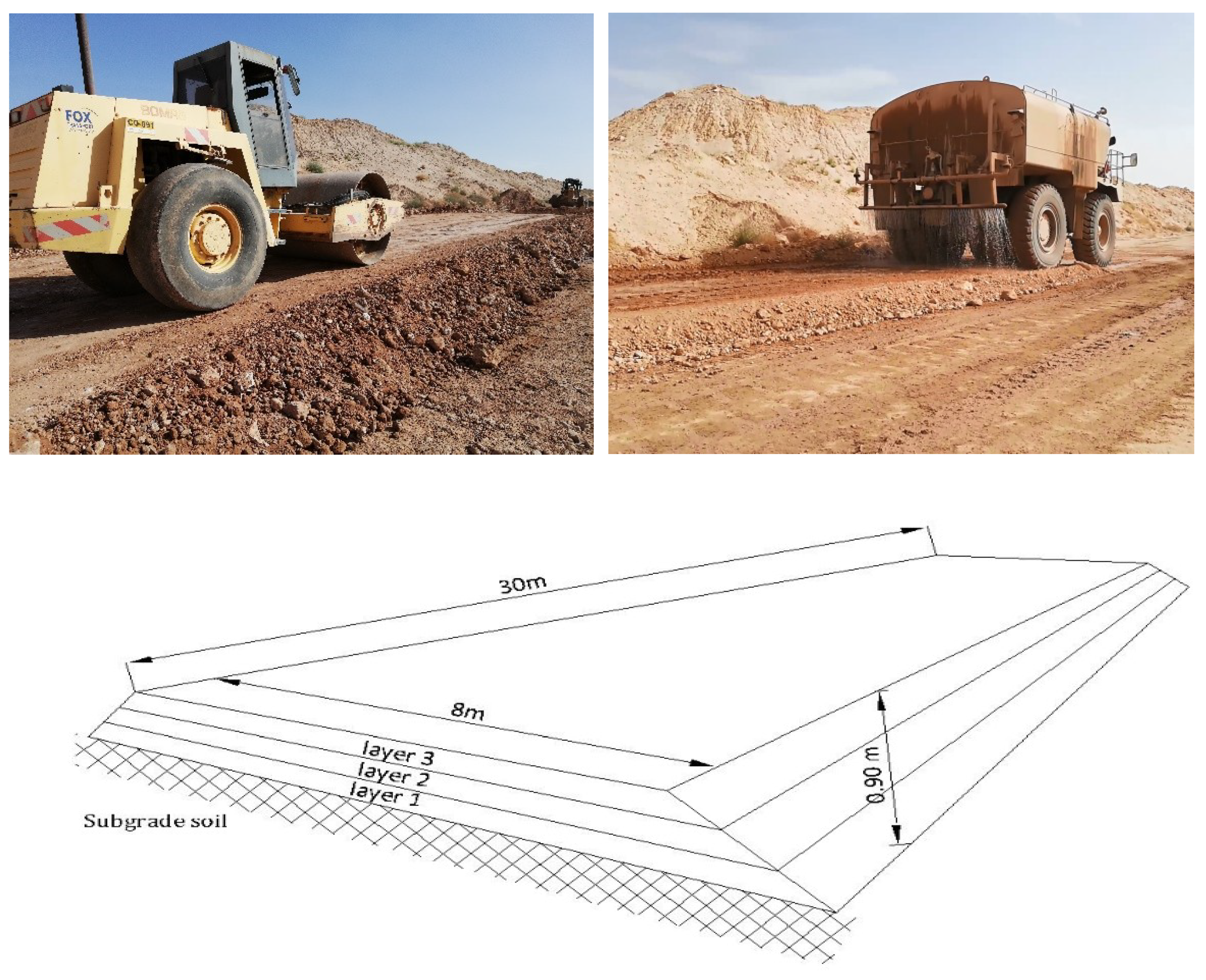
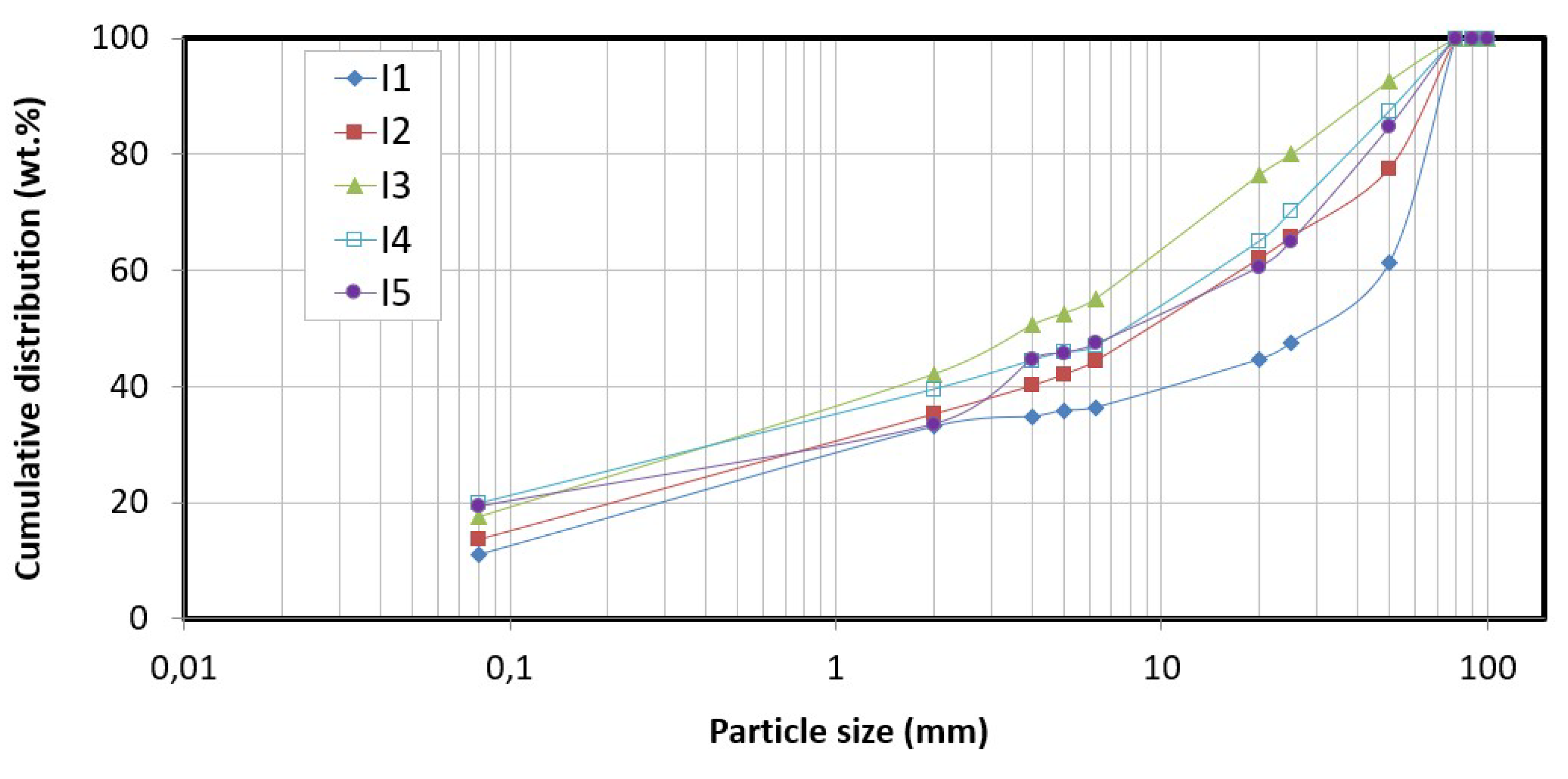
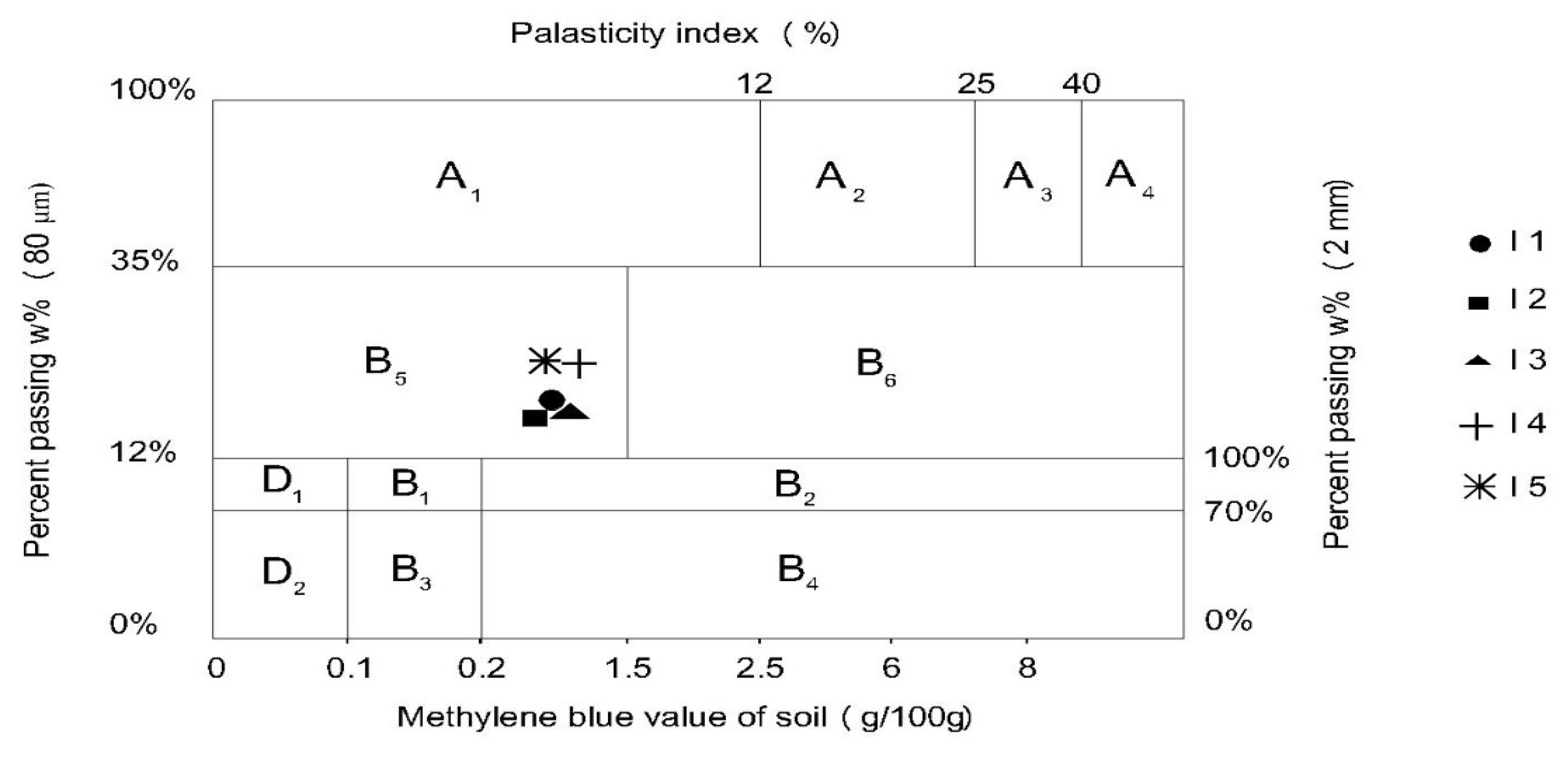
| Test | I1 | I2 | I3 | I4 | I5 | |
|---|---|---|---|---|---|---|
| Moisture Content | wt. % | 3.4 | 3.7 | 3.6 | 2.9 | 3.1 |
| Geotechnical properties—Natural parameters | ||||||
| Proctor Test | ||||||
| Optimum Moisture content (wopn) | wt. % | 13.40 | 12.90 | 15.20 | 14.60 | 13.23 |
| Maximum dry density γd max | kN/m3 | * | * | 17.9 | * | * |
| Shear test | ||||||
| Friction angle (Ø’) | degrees | 30.00 | 32.40 | 27.00 | 27.5 | 27.00 |
| Cohesion (c’) | kPa | 4 | 5 | 6 | 7 | 7 |
| CBR | % | * | * | 13 | * | * |
| Atterberg limit | ||||||
| Liquid limit | wt. % | 39 | 37 | 41 | 44 | 45 |
| Plastic limit | wt. % | 26 | 25 | 26 | 29 | 30 |
| Plasticity index | wt. % | 13 | 12 | 14 | 15 | 15 |
| Methylene blue value | g/100g | 0.59 | 0.58 | 0.67 | 0.68 | 0.71 |
| Carbonate content | wt. % | 30 | 29 | 33 | 32 | 33 |
| Geotechnical Properties–Mechanical behavior | ||||||
| Specific (particle) densi | kN/m3 | 2.61 | 2.65 | 2.56 | 2.6 | 2.58 |
| Los Angeles abrasion test 25/50 | wt. % | 48 | 46 | 66 | 67 | 53 |
| Mico Deval test 25/50 | wt.% | 55 | 50 | 68 | 70 | 54 |
| Degradability coefficient | wt.% | 10.10 | 9.10 | 13.80 | 14.60 | 12.70 |
| Fragmentability coefficient | wt.% | 8.90 | 7.50 | 10.10 | 11.40 | 10.50 |
| Material classification | - | C1B5 | C1B5 | C1B5 | C1B5 | C1B5 |
| PMWR Sample | I1 | I2 | I3 | I4 | I5 | |
|---|---|---|---|---|---|---|
| Major elements (wt. %) | ||||||
| SiO2 | 41.30 | 50.10 | 55.50 | 53.90 | 56.40 | |
| Al2O3 | 0.40 | 0.44 | 4.10 | 3.80 | 3.10 | |
| Fe2O3 | - | - | 0.50 | 0.40 | 0.30 | |
| CaO | 18.70 | 16.20 | 12.10 | 12.90 | 12.50 | |
| MgO | 9.10 | 7.20 | 4.90 | 5.50 | 5.40 | |
| K2O | - | - | 1.60 | 1.31 | 1.00 | |
| P2O5 | 4.22 | 5.40 | 5.10 | 4.70 | 4.20 | |
| LOI | 24.20 | 18.30 | 15.50 | 17.40 | 16.90 | |
| Corg | 0.21 | 0.18 | 0.31 | 0.44 | 0.38 | |
| S | 0.30 | 0.40 | 0.20 | 0.30 | 0.30 | |
| Mineralogical composition (wt. %) | ||||||
| Quartz | SiO2 | 41.21 | 49.80 | 32.00 | 30.10 | 33.60 |
| Cristobalite | SiO2 | 17.40 | 18.40 | 18.40 | ||
| Dolomite | (Ca,Mg)(CO3)2 | 40.89 | 32.00 | 21.00 | 24.00 | 24.00 |
| Calcite | CaCO3 | 6.04 | 5.00 | 3.90 | 3.50 | 3.70 |
| Fluorapatite | Ca5(PO4)3F | 6.42 | 6.20 | 8.30 | 8.10 | 7.90 |
| Albite | NaAlSi3O8 | 5.06 | 6.40 | 6.20 | 5.60 | 4.90 |
| Illite | (K,H3O)(Al,Mg)2(Si,Al)4O10[(OH)2,(H2O)] | 11.00 | 9.20 | 6.50 | ||
| Anorthite | CaAl2Si3O8 | 0.38 | 0.60 | 0.44 | 0.80 | 0.90 |
| Sample | Zn | Se | Pb | Cu | Cr | Cd | As | V |
|---|---|---|---|---|---|---|---|---|
| mg/L | mg/L | mg/L | mg/L | mg/L | mg/L | mg/L | mg/L | |
| I1 | 0.55 | <0.10 | <0.60 | <0.50 | <0.20 | <0.10 | <1 | <1 |
| I2 | 0.62 | <0.10 | <0.60 | <0.50 | <0.20 | <0.10 | <1 | <1 |
| I3 | 0.73 | <0.10 | <0.60 | <0.50 | <0.20 | <0.10 | <1 | <1 |
| I4 | 0.54 | <0.10 | <0.60 | <0.50 | <0.20 | <0.10 | <1 | <1 |
| I5 | 0.56 | <0.10 | <0.60 | <0.50 | <0.20 | <0.10 | <1 | <1 |
| Limits (US-EPA) | 2 | 1 | 5 | - | 5 | 1 | 5 | - |
| State of Material | Before Compaction | After Compaction | |||||
|---|---|---|---|---|---|---|---|
| Compaction Energy | 2 Passes | Evolution (%) | 4 Passes | Evolution (%) | 8 Passes | Evolution (%) | |
| <0.08 mm (wt. %) | 19.20 | 21.00 | 9. 38 | 22. 70 | 18.23 | 22. 73 | 18. 39 |
| <2 mm (wt. %) | 37.60 | 40.20 | 1.60 | 41.00 | 9.04 | 41.10 | 9.31 |
| <20 mm (wt. %) | 63.80 | 68.00 | 6.58 | 71.00 | 11. 29 | 71.20 | 11.60 |
| <50 mm (wt. %) | 89.20 | 95.00 | 6. 50 | 96.00 | 7. 62 | 96. 10 | 7.74 |
| <2mm (0/50 mm) (wt. %) | 42.15 | 42.32 | 0.39 | 42.71 | 1.32 | 42.77 | 1.46 |
| <0.08 mm (0/50 mm) (wt. %) | 21.52 | 22.11 | 2.70 | 23.65 | 9.85 | 23.65 | 9.89 |
| MBV (g/100g) | 0.57 | 0.61 | 7.02 | 0.66 | 15.79 | 0.67 | 17.54 |
| Layer | First Layer | Second Layer | Third Layer | |||||||
|---|---|---|---|---|---|---|---|---|---|---|
| Compaction Energy | 2 Passes | 4 Passes | 8 Passes | 2 Passes | 4 Passes | 8 Passes | 2 Passes | 4 Passes | 8 Passes | |
| reference dry density (kN/m3) | 19.5 | |||||||||
| Surface | dry density (kN/m3) | 18.2 | 19.4 | 19.0 | 18.4 | 19.4 | 19.1 | 18.2 | 19.5 | 19.1 |
| compaction rate (%) | 93 | 99 | 97 | 94 | 99 | 98 | 93 | 100 | 98 | |
| Bottom | dry density (kN/m3) | 17.4 | 18.2 | 18.1 | 17.5 | 18.0 | 18.0 | 17.3 | 18.3 | 17.8 |
| compaction rate (%) | 90 | 96 | 95 | 91 | 96 | 94 | 90 | 95 | 96 | |
| Compaction Energy | 2 Passes | 4 Passes | 8 Passes | ||
|---|---|---|---|---|---|
| Plate test (average of six points) | standard deviation | % | 2.23 | 2.52 | 2.68 |
| EV1 | MPa | 45.70 | 57.30 | 57.10 | |
| EV2 | MPa | 79.80 | 91.20 | 89.40 | |
| K (EV2/EV1) | - | 1.75 | 1.59 | 1.57 | |
| Moisture Content (wt. %) | Compactor Class | Compactor Speed (km/h) | Compaction Energy | Thickness (m) |
|---|---|---|---|---|
| Average (0.9 à 1.1) wopn | V4 (vibratory compactor roller) | 4 | 4 passes | 0.30 |
| Characteristics of the Material | Risk | Proposed Remedies |
|---|---|---|
| Limited mechanical strength (presence of clay) |
| respect the optimum conditions of use (in situ tests) |
| Presence of rock of different petrographic origin (heterogeneity) |
|
|
© 2019 by the authors. Licensee MDPI, Basel, Switzerland. This article is an open access article distributed under the terms and conditions of the Creative Commons Attribution (CC BY) license (http://creativecommons.org/licenses/by/4.0/).
Share and Cite
Amrani, M.; Taha, Y.; Kchikach, A.; Benzaazoua, M.; Hakkou, R. Valorization of Phosphate Mine Waste Rocks as Materials for Road Construction. Minerals 2019, 9, 237. https://doi.org/10.3390/min9040237
Amrani M, Taha Y, Kchikach A, Benzaazoua M, Hakkou R. Valorization of Phosphate Mine Waste Rocks as Materials for Road Construction. Minerals. 2019; 9(4):237. https://doi.org/10.3390/min9040237
Chicago/Turabian StyleAmrani, Mustapha, Yassine Taha, Azzouz Kchikach, Mostafa Benzaazoua, and Rachid Hakkou. 2019. "Valorization of Phosphate Mine Waste Rocks as Materials for Road Construction" Minerals 9, no. 4: 237. https://doi.org/10.3390/min9040237
APA StyleAmrani, M., Taha, Y., Kchikach, A., Benzaazoua, M., & Hakkou, R. (2019). Valorization of Phosphate Mine Waste Rocks as Materials for Road Construction. Minerals, 9(4), 237. https://doi.org/10.3390/min9040237








